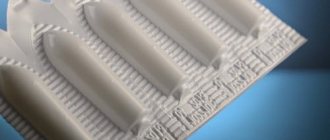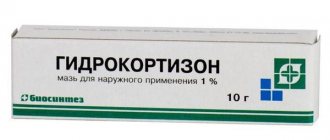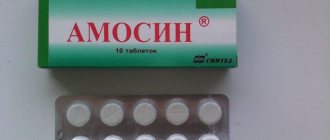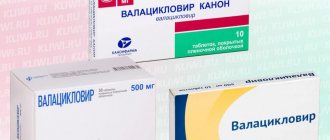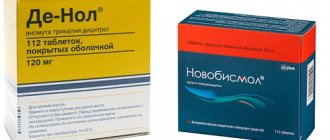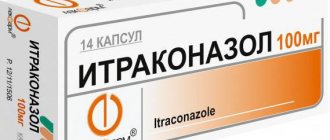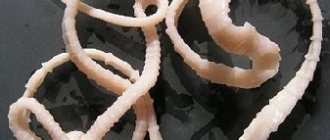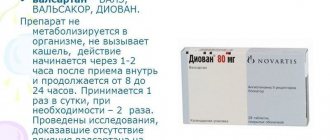Brief instructions for using capsules
Phosphogliv is available in capsules and is taken several times a day depending on the indications. The dosage of the drug is determined by the attending physician. The effectiveness of individual components of the drug has been proven in several studies.
Composition of the drug
Active substances in Phosphogliv:
- phospholipids;
- trisodium glycyrrhizinate.
Glycyrrhizin is a glycoside found in licorice root, belonging to the class of saponins. The active substance has an anti-inflammatory and stimulating effect on liver regeneration. Glycyrrhizin inhibits the enzyme 11-beta-hydroxysteroid dehydrogenase, which in a physiological situation catalyzes the formation of cortisol from cortisone.
Cortisol may act similarly to aldosterone at mineralocorticoid receptors, resulting in increased renal tubular reabsorption of sodium and water and increased blood pressure.
Phosphatidylcholines are a class of phospholipids that are the main component of biological membranes. On an industrial scale, phospholipids are obtained from egg yolk or soybeans. The active substance is part of the group of lecithins - yellow-brownish fatty substances found in the tissues of animals and plants.
What is this medicine for?
Phosphogliv is mainly used to treat non-alcoholic and alcoholic fatty liver disease, toxic or drug-induced liver damage.
What Phosphogliv is rarely used for:
- viral inflammation of the liver;
- chronic liver disease, accompanied by irreversible replacement of parenchymal connective tissue;
- chronic non-infectious skin diseases.
How to use
According to the instructions for use, Phosphogliv capsules are taken orally with a small amount of liquid. It is not recommended to chew the drug. The duration of use is determined by the attending physician and can reach six months. Your doctor will tell you exactly how to take Phosphogliv.
Before or after meals
How to take phosphogliv - before or after meals - will be determined by your doctor. The drug is recommended to be used during or after meals with a small amount of liquid.
Dosage
According to the instructions for use of Phosphogliv in capsules, the dosage is set based on the indications, health status, age and wishes of the patient. The maximum recommended dose for adults and children is 4-6 capsules per day. The dosage of Phosphogliv is determined by the attending physician.
Efficacy studies
Clinical and experimental studies show that glycyrrhizic acid has anti-inflammatory, antiviral, antimicrobial, antioxidant and antitumor effects. Animal experiments have demonstrated weak modulating immune responses and liver- and heart-protective effects.
A study published May 5, 2020 in Clinical and Experimental Gastroenterology found that phosphatidylcholines normalize liver cell function, blood fat levels, and reduce inflammation. Due to their positive effect on the composition and function of the membrane, they accelerate the recovery of patients with fatty liver disease.
A persistent inflammatory response secondary to congenital or acquired biliary cholestasis plays an important role in the pathophysiology of liver tissue damage. Phosphatidylcholines have been shown to suppress inflammatory responses in vivo and in vitro. Phospholipids have also been shown to protect against various types of experimental liver injury in animal models and isolated liver cells.
In a Swiss study, albino rats of different sexes were divided into 4 groups as follows:
- control group (group 1: 10 rats);
- rats that underwent surgery and were treated with saline (group 2: 10 rats);
- rats with biliary obstruction (group 3: 15 rats);
- rats with biliary obstruction treated with phosphatidylcholine (group 4, 15 rats).
Liver functions
Phosphatidylcholine treatment was started 2 weeks after biliary obstruction at doses of 0.05 g/day per rat and continued for the next 2 weeks. After 4 weeks the experiment ended. Liver damage and cholestasis were determined by biochemical and histological studies.
Data showed a decrease in plasma bilirubin levels (both conjugated and unconjugated) and liver enzyme levels (AST, ALT, AP, GGT, 5′-NT) in the fourth group compared with the third group. The level of malondialdehyde in group 4 was 20.00 ± 2.93, and in group 3 - 27.12 ± 2.96.
Swiss study conclusion: Phosphatidylcholine reduces liver damage and fibrosis in rats with biliary tract obstruction.
The observed effects confirm that phosphatidylcholine may be a useful agent for preserving liver function in patients with biliary obstruction.
Can it be used for prevention?
Phosphogliv prevents acetaldehyde-mediated collagen accumulation, which prevents liver fibrosis. This effect was also studied in humans in a randomized, placebo-controlled clinical trial that lasted almost 20 years, showing that phosphatidylcholine improved the condition of patients with alcoholic liver disease.
Phosphogliv prevents not only the development of alcoholic cirrhosis, but also early liver changes caused by alcohol consumption - hyperlipidemia. Phospholipids help prevent lipid accumulation in the liver. A study in rats demonstrated that phosphatidylcholine reduced the concentration of triglycerides in the liver, which in high doses are indicative of viral hepatitis or cirrhosis. How to take Phosphogliv for prevention is determined by your doctor.
Lyophilisate for injections
Phosphogliv lyophilisate has the same indications as the oral form of the drug. Injections with Phosphogliv are strictly contraindicated for some patients. The most common adverse effects are pain or discomfort at the injection site.
Composition of ampoules
The drug Phosphogliv is available in the form of a lyophilisate for injections, which contains 0.5 g of lipoid C100 and 0.2 g of sodium glycyrrhizinate. The main excipient in Phosphogliv ampoules is maltose.
To dissolve the drug, it is recommended to use only clean distilled water. It is not recommended to dilute Phosphogliv with sodium chloride or glucose solution.
Indications
Indications for use are similar to those of the oral drug. Phosphogliv in ampoules is used for the treatment of viral inflammation of the liver, fatty hepatosis, alcoholic, toxic or drug-induced liver damage, cirrhosis, as well as for the treatment of dermatitis of various etiologies.
According to the instructions for use, Phosphogliv injections can be given to children and adults. Before administration, it is necessary to dissolve the powder in 0.1 deciliters of clean water. The instructions for using Phosphogliv in ampoules also state that the drug should be administered in 0.1 deciliter doses several times a day.
Contraindications
Absolute contraindications to the use of Phosphogliv:
- hypersensitivity to glycyrrhizin, phosphatidylcholine or excipients;
- antiphospholipid antibody syndrome;
- pregnancy;
- breast-feeding;
- age up to 12 years.
Relative contraindications:
- portal hypertension;
- hypertonic disease.
Phosphatidylcholine may reduce the effect of anticholinergics such as scopolamine, antihistamines and some antidepressants.
Phospholipids increase the concentration of acetylcholine in the body. Acetylcholinesterase inhibitors also increase its content in the nervous system. Taking phosphatidylcholine along with donepezil (Aricept), tacrine (Cognex), rivastigmine (Exelon) and galantamine (Reminyl) increases the side and main effects of the latter.
Side effects
Injections cause hyperemia, arterial hypertension, swelling of the skin, erythema and pain at the injection site. The side effects of Phosphogliv usually go away within a few days.
Sometimes Phosphogliv causes gastrointestinal side effects - flatulence, diarrhea and vomiting. If Phosphogliv is injected directly into a benign fatty growth (lipoma), it can cause an inflammatory reaction.
What is better in comparison with Phosphogliv
Hepatoprotectors available on the pharmaceutical market differ significantly not only in composition, but also in their mechanism of action. The choice of drug therapy should be made by a physician based on the patient’s individual tolerability of the drug and associated complications.
Essentiale N
The drug contains essential phospholipids (93% phosphatidylcholine) in a dose of 250 mg and is available in ampoules. Injection of phospholipids is advisable at the initial stage of treatment, after which they switch to oral administration of the drug.
Unlike Essentiale N, Phosphogliv contains trisodium glycyrrhizinate, which enhances the therapeutic effect of phospholipids.
Which is better - Phosphogliv or Essentiale N - will be determined by the doctor for each individual patient, depending on the state of health. Phosphogliv is not recommended for people with high blood pressure, so Essentiale may be an acceptable alternative.
Essentiale forte N
"Essentiale forte N" contains essential phospholipids (76% phosphatidylcholine) in a dose of 300 mg and is available in the form of capsules for oral administration. Contains approximately 30% less phosphatidylcholine than in the Essentiale N ampoule, but this is enough for a therapeutic effect.
As for comparison with Phosphogliv, it is recommended to take Essentiale in case of hypertension. In other cases, Phosphogliv is considered more effective due to the additional component in the composition - trisodium salt of glycyrrhizic acid.
Essliver
Essliver stimulates liver regeneration and also reduces blood sugar and cholesterol levels not only due to phospholipids, but also thiamine, riboflavin, pyridoxine, cyanocobalamin, nicotinamide, alpha-tocopherol. The combination drug is produced mainly in the form of capsules.
Which is better - Phosphogliv or Essliver - depends on contraindications and indications. The first drug affects blood pressure, while the second has no hypertensive effect. Therefore, in case of arterial hypertension, it is recommended to give preference to Essliver, which is also more suitable for patients with hypovitaminosis.
Essliver capsules
Rezalut Pro
Rezalut Pro, unlike the above hepatoprotectors, contains polyunsaturated phospholipids, glycerin, triglycerides, soybean oil and vitamin E. The medication is available in the form of capsules for oral use.
Rezalut Pro accelerates the regeneration of hepatocytes, suppresses the formation of collagen in the liver and inhibits the oxidation of lipid molecules. The medicine normalizes the level of cholesterol and fats in the bloodstream. Unfortunately, Rezalut Pro is not recommended for patients with peanut or soy allergies.
Which is better - Phosphogliv or Rezalut Pro - depends on whether the patient has hypersensitivity to soy, peanuts and blood pressure levels. For hypertensive patients without allergies, Rezalute Pro is suitable, while people with normal blood pressure and allergies to peanuts or soy are recommended to take Phosphogliv.
Heptral
Heptral contains ademetionine, which belongs to the group of hepatoprotectors. Although numerous lines of evidence from laboratory tests in cells and animal models suggest that ademetionine may be useful for the treatment of various liver diseases, the drug has not been studied in any large randomized, placebo-controlled clinical trials that would evaluate its therapeutic or side effects.
Which is better - Heptral or Phosphogliv - depends on the indications. Since admetionine has an antidepressant effect, it is recommended for patients with depression. However, due to the lack of proven effectiveness, it is recommended to give preference to Phosphogliv.
Ursosan
Ursosan contains ursodeoxycholic acid, which is a highly hydrophilic bile acid that dissolves cholesterol and fat in the intestines.
The drug is approved for the maintenance treatment of liver damage and the treatment of hepatitis C. Ursosan is considered the first line of treatment for primary biliary cirrhosis.
Which is better - Ursosan or Phosphogliv - depends on the form of liver damage. For biliary cirrhosis and hepatitis, the effectiveness of Ursosan is higher, so it is recommended to give preference to this drug. For fatty liver disease, Phosphogliv may be more beneficial.
Karsil
Carsil is a standardized milk thistle fruit extract that contains a high concentration of silymarin.
According to clinical studies, silymarin reduces inflammatory processes in the liver and accelerates its recovery. However, the reported beneficial effects of the drug have not been replicated in some large scientific studies. Therefore, the effectiveness of silymarin is questionable. Which is better - Carsil or Phosphogliv - depends on the degree of liver damage. In case of severe fatty hepatosis or hepatitis, it is recommended to give preference to the latter drug. For “mild” liver diseases, Karsil is suitable.
Side effects
"Phosphogliv forte" can cause the following side effects:
- dermatological rashes (usually disappear after discontinuation of the hepatoprotector);
- accumulation of fluid in the tissues of the extremities;
- blood pressure surges;
- decreased serum potassium concentration.
This usually occurs due to sodium and fluid retention in the body due to exceeding prescribed doses of the medication.
Depending on the severity of side effects, reduce the dose of the drug and/or prescribe a diuretic.
Phospholiv forte
Phospholipids in combination with the trisodium salt of glycyrrhizic acid are also the active ingredients of the drug "Phosphogliv Forte", produced in capsules. The difference from regular Phosphogliv (in capsules) is in the dose of the listed components. If in Phosphogliv the active substances are presented in an amount of 65 + 35 mg, then in Phosphogliv Forte - 300 + 65 mg (phospholipids and sodium glycyrrhizinate, respectively). Thus, “Phosphogliv Forte” has a more pronounced effect, which, nevertheless, should not serve as a reason for independently replacing one drug with another.
What is it used for?
Phosphogliv is actively used for the prevention and complex treatment of those patients who have chronic and acute forms of viral hepatitis.
Helps with cirrhosis and toxic liver damage, copes with steatohepatitis and steatohepatosis.
As for the oral form, it is suitable for the combined treatment of eczema, neurodermatitis, psoriasis, and various intoxications.
Be sure to read:
The healing properties of peppermint essential oil


